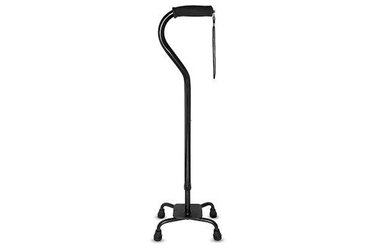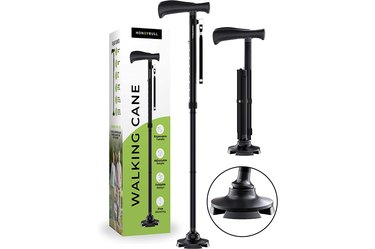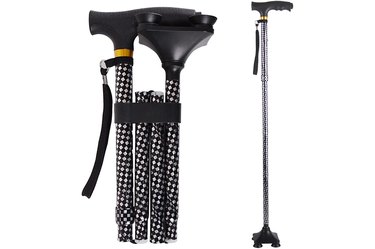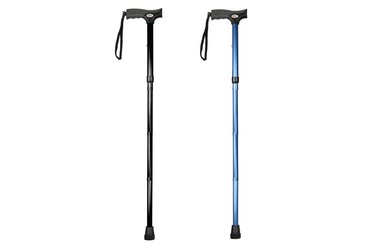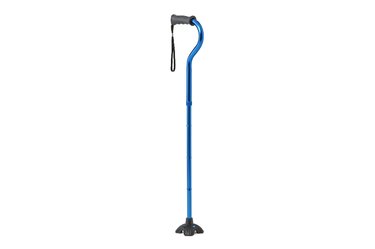
If you've recently had a hip replacement, your doctor likely recommended you use a cane as your body starts to recover. Canes can help with walking by providing added stability, increasing muscle action and reducing weight-bearing load, explains Robert L. Parisien, MD, orthopedic sports medicine surgeon at Mount Sinai and team physician for U.S. Ski & Snowboard and USA Fencing.
Whether your surgeon took the anterior or posterior approach to your hip surgery, they had to go through your muscle, and you'll need a recovery period to gain back your strength in this area, says Lisa Cannada, MD, an orthopedic trauma surgeon with Novant Health in Charlotte, North Carolina. Using a cane can be very helpful during this time.
Video of the Day
Video of the Day
The Best Canes to Use After a Hip Replacement
- RMS Quad Cane ($39.99; Amazon)
- HONEYBULL Walking Cane ($21.24; Amazon)
- YOKABOZE FreeStanding Cane ($24.99; Amazon)
- Carex Soft Grip Derby Adjustable Walking Cane ($19.99; Amazon)
- Medline Offset Folding Cane ($21.99; Amazon)
How We Chose
We chatted with orthopedic physicians who broke down the most important attributes of cane for use after a hip replacement. Our top picks are based on their criteria, including:
- Height
- Weight
- Durability
- Material
- Adjustability
1. RMS Quad Cane
Four-prong feet styles like this one help provide more stability than a single prong at the bottom, says Chris James, MD, an adult reconstruction and robotic-assisted hip and knee surgeon based in Palm Harbor, Florida.
The ergonomic handle and adjustable height also provide the right level of stability.
The height is especially important — if a cane is too high or too low, it will affect gait and balance, warns Dr. James.
Buy it: Amazon ($39.99); Walmart.com ($49.99)
2. HONEYBULL Walking Cane
This cane offers five different adjustable heights, so there's almost a guarantee you'll find one to perfectly accommodate your stature so you can move with ease after your hip replacement.
It is free-standing, extra wide and is four-pronged at the feet to provide added stability. It's also lightweight and foldable, which makes it great for travel, and it comes in a range of colors.
Buy it: Amazon; Price: $27.99
3. YOKABOZE FreeStanding Cane
This four-pronged cane has all of the stability and durability you need to help assist you with walking post-surgery. It also features an anti-slip base, 360-degree swivel and T-shaped grip that makes it easy to hold on to.
Perhaps one of its most sought-after features is its built-in LED light system, which helps you maneuver around at night in poorly lit areas or without the need to turn on a light.
Buy it: Amazon; Price: $24.99
4. Carex Soft Grip Derby Adjustable Walking Cane
Dr. James is a fan of this soft-grip derby-style cane, which he recommends for younger, healthier hip patients.
It doesn't have a four-pronged bottom, so it's not a free-standing cane, but "It is lightweight and the shaft aligns well with the arm, which can help cut down on wrist pain," Dr. James says.
The cane has a weight capacity of 250 pounds, features an anti-slip grip and comes in five different colors.
Buy it: Amazon ($19.99); Carex.com ($27.99); Walmart.com ($32.03)
5. Medline Offset Folding Cane
If you're looking for a lightweight cane that can fold easily to fit into a suitcase or briefcase, this is a great buy.
It has a four-pronged leg that helps ensure stability and an offset handle that properly aligns your hand right over the cane.
The gel-cushioned grip also makes for comfortable and sturdy maneuvering.
Buy it: Amazon; Price: $21.99
What to Look for in a Walking Cane
1. Height
Craig Mahoney, MD, a Des Moines-based orthopedic surgeon and Fellow of the Academy of Orthopaedic Surgeons, recommends that the height of your cane be at the wrist level of your arm with your arms hanging at your sides when you are standing.
"This will give you the appropriate amount of bend in your elbow and will allow you to distribute force with your arm," he says.
2. Handle or Grip
When selecting a cane, Dr. Parisien recommends identifying the handle or grip that is most comfortable and best fits your particular hand.
Soft-grip canes tend to be ideal for younger people, while those with a firmer grip tend to be more ideal for older adults who may be a bit more unstable, notes Dr. James.
3. Adjustability
It is most ideal if your cane is adjustable. This way, you can lengthen or shorten the cane to accommodate your specific height and arm length.
A too-high or too-low cane will affect your gait and balance. "You want to ensure the gait is as close to normal as possible," Dr. James says.
4. Weight
You want to make sure your cane is lightweight enough for you to easily maneuver it. In other words, it shouldn't cause you any additional trouble in regards to moving around because it's heavy or bulky — rather it should help facilitate all your movements.
5. Stability and Durability
The cane should also be durable and should, ideally, be very stable in its use.
"If the bottom surface of the cane (the part that touches the floor) is too small or easily slips, that defeats the purpose of the cane in the first place," says Scott Dhupar, MD, an orthopedist in Greeley, Colorado.
Transitioning From a Walker to a Cane
Every person's recovery from a hip replacement is different and, therefore, the healing timeline can vary significantly. Most often, however, a normal-functioning person who was not using a walker or cane prior to the hip replacement will spend about one to two weeks with a walker before transitioning to a cane post-surgery, Dr. James says.
"Typically, it's two weeks with a walker and then transition to a cane," he says. "When I see the patient after four weeks, they're usually not using anything."
During this transition, it is very important that the cane be fitted properly.
"When a cane is being used normally, you want your elbow bent slightly, approximately 20 degrees, which can be measured by your physical therapist," Dr. Cannada says.
She recommends that the height of the cane be such that the top of it sits at your hip bone, which is in the upper part of the thigh.
How to Walk With a Cane After a Hip Replacement
The right way to use a cane is in the hand of the opposite side of the hip replacement, so that the cane and the leg that had the hip replacement move at the same time.
"This is a natural extension of a normal gait — as you walk your right leg and left arm swing out at the same time," Dr. Cannada says. "Having the cane on the opposite side of the hip that was replaced gives you a broad base of support, and this improves your balance as you get increasingly stronger."
- Robert L. Parisien, MD, Orthopedic Sports Medicine Surgeon at Mount Sinai and Team Physician for US Ski & Snowboard and USA Fencing
- Lisa Cannada, MD, orthopedic trauma surgeon with Novant Health in Charlotte, North Carolina
- Craig Mahoney, MD, Des Moines-based orthopedic surgeon and Fellow of the Academy of Orthopaedic Surgeons
- Scott Dhupar, MD, orthopedist in Greeley, Colorado.
Is this an emergency? If you are experiencing serious medical symptoms, please see the National Library of Medicine’s list of signs you need emergency medical attention or call 911.
